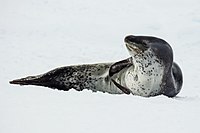
Photo from wikipedia
Abstract Transfrontier conservation areas (TFCAs) have the potential to provide havens for large carnivores while preserving connectivity across wider mixed-use landscapes. However, information on the status of species in such… Click to show full abstract
Abstract Transfrontier conservation areas (TFCAs) have the potential to provide havens for large carnivores while preserving connectivity across wider mixed-use landscapes. However, information on the status of species in such landscapes is lacking, despite being a prerequisite for effective conservation planning. We contribute information to this gap for leopard (Panthera pardus) in Africa, where the species is facing severe range contractions, using data from transect surveys of a 30,000km2 area across Botswana and Zimbabwe in the Kavango-Zambezi (KAZA) TFCA. We used occupancy models to assess how biotic, anthropogenic, and management variables influence leopard habitat use, and N-mixture models to identify variables influencing the species' relative abundance. Leopard were detected in 184 out of 413 sampling units of 64km2; accounting for imperfect detection resulted in mean detection probability p ¯ = 0.24 (SD = 0.06) and mean probability of site use ψ ¯ = 0.89 (SD = 0.20). Habitat use was positively influenced by prey availability and high protection. Relative abundance was best predicted by trophy hunting, which had a negative influence, while abundance was positively associated with high protection and availability of steenbok. Our findings suggest that securing prey populations should be a priority in conservation planning for leopard in Africa, and underline the necessity of preserving highly-protected areas within mixed-use landscapes as strongholds for large carnivores. Our findings also support calls for better assessment of leopard population density in trophy hunting areas, and illustrate the value of N-mixture models to identify factors influencing relative abundance of large carnivores.
Journal Title: Biological Conservation
Year Published: 2020
Link to full text (if available)
Share on Social Media: Sign Up to like & get
recommendations!